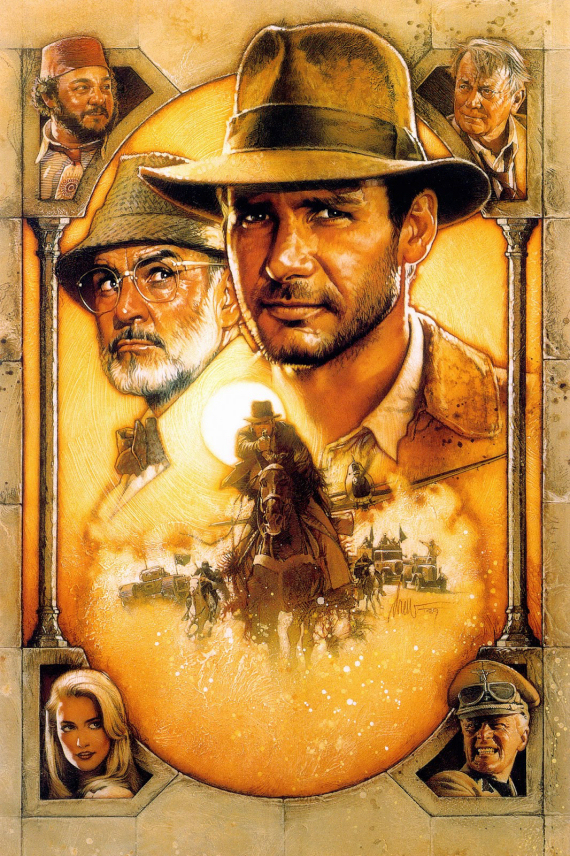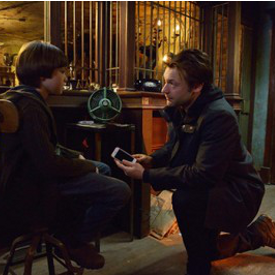
I remember, back in 1981, in Pullman, Washington, I met PESFA* member Jane Fancher in the grocery store and she started raving about this movie she and her sister Lynn had just seen, called Raiders of the Lost Ark. By the time I got to see it, the lines at the Old Post Office Theatre (which had actually been the Pullman Post Office—my desk at home came out of that when they closed the office (but I digress)—the lines were around the block. I was blown away by the new take on the old Perils of Pauline genre—but then, most of us were, right? *PESFA—the Palouse Empire (roughly the area around Spokane, WA down to Pullman and somewhat east, including Moscow, ID) Science Fiction Association, which was a group I’d started a few years previous with my then best friend, the late Jon Gustafson. This column won’t be talking about the TV series about young Indiana Jones (mainly because I didn’t watch it when it was on—1999 & 2000—and I can’t find it to watch it now), but will focus on the Lucas/Spielberg films we all know.
Of course, I was already familiar with Ford as Han Solo from Star Wars (1977), but some of my contemporaries had also seen American Graffiti (1973), which I still haven’t actually watched, though I’ve seen much of it by now (I have seen its sequel, however). Through Raiders, we also met John Rhys-Davies’ character Sallah, and Karen Allen’s Marion Ravenswood. Set in approximately 1936, Raiders was a somewhat serious take on the old serials as noted before, with Nazis as the villains and Karen Allen as the love interest. She was a strong female character and a match for Indy.

The second Indiana Jones movie, Indiana Jones and the Temple of Doom (1984), (Figure 2) was much darker (and is probably now considered pretty racist in major chunks) and in part, helped with the formation of the NC-17 rating. I found it kind of clunky in part and not helped by the inclusion of Steven Spielberg’s then-squeeze (as I understand it) Kate Capshaw, whose character set my teeth on edge. (The major female characters in this series seem to me to be often flawed.) It was set in the mid-1930s, around 1935) and had a quick but rather effective look at Hong Kong in that period. (We also met Ke Huy Quan as “Shorty,” or Short Round, little knowing that he’d make notable comebacks in such later films and TV series as The Goonies, Everything Everywhere All at Once, and Loki.) Anyway, overall, I enjoyed it, and was ready for the next one, which introduced…

Sean Connery as Indy’s dad, Henry Jones Senior! Indiana Jones and the Last Crusade (1989) is still thought of as one of the best Indy movies (Figure 3). Here we delve into Indy’s youth for the first time, with River Phoenix as young Indy. (We also find out how Indy got acquainted with a bullwhip and, incidentally, how he got that scar on his chin.) Back with older Indy we find him up against the Nazis again (probably in the 1940s), and his comedic turns with Connery enlivened the movie. The annoying female character this time was Alison Doody as Dr. Elsa Schneider. We also see Denholm Eliot as Indy’s university colleague Marcus Brody, and Sallah again aids Indy in his quest for the Holy Grail (literally, this time). I should also point out that in this series up to this point, CGI was used rather sparingly and very effectively; for example, the Ark of the Covenant scene in Raiders. This movie mixes humour and action is approximately equal portions and is considered a high-water mark in the series.

CGI really comes into its own with the next movie, Indiana Jones and the Kingdom of the Crystal Skull (2008) (Figure 4). It was a long wait for the fans after Last Crusade, but even so, some fans weren’t overly impressed. The year portrayed here is sometime in the early 1950s, and the action seems a bit “iffy” at times, with an older Indy escaping an atomic blast inside a refrigerator. But this time the enemy isn’t Nazis, but Soviets, led by the evil Irina Spalko (Cate Blanchett). We learn that Indy has a son, Mutt (Shia LaBeouf), and we meet other friends in the persons of John Hurt as Prof. Oxley and his old frenemy, Mac (Ray Winstone). The McGuffin this time is an elongated skull made of crystal which is strangely magnetic. Blanchett is excellent as the epee-wielding Russian, and LaBeouf is repellent as a mouthy switchblade-carrying delinquent. The CGI really comes into play in the final action scenes featuring dimension-traveling aliens. (My wife and I were lucky to meet and become friends with one of the conceptual designers of the film, the extremely talented Miles Teves. Check out his website in the link!)

This year, 2023, marks the opening of what may well be Harrison Ford’s final appearance as Indiana Jones; after all, Ford is now 81 and would have to depend on stunt actors to do most of his walking, let alone stunts, in future Indy films if there were any. (This is also the first Indy movie not to be produced or directed by Spielberg or Lucas. James Mangold directed and co-wrote it, while the other two serve as executive producers.) On the other hand (OTOH, as they say), since the early part of this latest movie—Indiana Jones and the Dial of Destiny (I understand they wanted to call it Indiana Jones and the Antikythera of Archimedes, but were told nobody could pronounce it so nobody would come to the theatres) takes place in 1944 in Austria, while the Nazis were plundering like mad while the war wound down around them. So Jones (played by two different people besides Ford) was de-aged by an AI-powered computer. And I think they did a sterling job; Ford looks pretty much like he did 20+ years ago. So they could possibly do it again, presuming Ford wants to.
If you’ve not seen the movie, I’ll give you a précis: Indy and his pal Basil Shaw (Toby Jones) are trying to retrieve the Sword of Longinus from a Nazi loot train (for a really vivid scene involving this sword see the film Constantine, with Keanu Reeves). The sword is supposedly the one that pierced Jesus Christ’s side, giving it mystical powers; Hitler had soldiers out searching for all kinds of supposed powerful items. They discover that the Antikythera built by Archimedes (you remember him, eh? “Eureka!” and a naked run through the streets from his bathtub? Well, Vitruvius probably made it up, but it makes a great story.) is on the train and steal it. (Supposedly he made this intricate geared object in the third century B.C.; and it had mystical powers to detect rifts in time. But he split it into two pieces to keep it from the Romans, who were besieging Syracuse). Indy takes it from a Jurgen Voller (Mads Mikkelson). In present-day (1969) New York, Indy is about to retire, when Helena Shaw (Phoebe Waller-Bridge), his god-daughter and the late Basil Shaw’s daughter, steals the Antikythera from Hunter University, where Indy teaches, and goes on the run, pursued by none other than Voller, who is a big part of the U.S.’s space race under the name of Schmidt.
The pursuit takes Indy, Helena, Voller and us from New York to Morocco, to Greece with lots of chases: car chases, horse chases, motorcycle chases, boat chases, airplane chases and foot chases! Standard Indiana Jones stuff to be sure. We meet a diver (Antonio Banderas) and learn that Mutt, Indy’s son, died in Vietnam; his wife Marion (Karen Allen) has filed for a legal separation (leaving Indy free for all these chases, incidentally). They need to find something called The Graphikon (which means, basically, something graphic) which gives the location of the other part of the Antikythera. They eventually find it and do a bit of time traveling. (I’m trying not to spoil too much for those who haven’t seen it yet.)
In the end, Voller is done for, Indy and Marion reconcile and all is right with the world (the last shot of the film hints that there may be more to come….)
The character of Helena is supposed to be charming and roguish, I believe, though I found her even more annoying than Kate Capshaw or Alison Doody. She’s like a feminine version of Indy, extremely capable, but dedicated solely to the pursuit of money. At one point she professes to believe in nothing but cash. (She eventually redeems herself, but I still found the character to have few redeeming qualities.) Of course, like all the Indy movies, this one skilfully mixes fact and fantasy. The Antikythera does exist, but it’s hardly in pristine condition as is the one in the film. It is, in fact, believed to be an orrery of sorts. (An orrery is a mechanism that mimics or shows the relative position [and sizes, usually] of the planets, like the one in The Dark Crystal, Pitch Black, or the first Angelina Jolie Tomb Raider movies.) Archimedes is supposed to have (believed by some to have) invented the sun-powered mirror weapon (“death ray”) shown in this movie, though opinions differ as to the reality. Figure 6 shows the real Antikythera and what it’s theorized to have originally looked like.

But the truth is, these movies aren’t about the McGuffin, they’re about creating a modern audience-pleasing legend in the cliffhanger serials tradition, skilfully mixing truth with fiction to create the world Indy lives and works in. And despite a number of stumbles on the way—everyone has their own opinions of which films are good and which aren’t—people continue to want to see the character. Harrison Ford is a big part of it, and to keep on making Indy movies without him probably would be a disservice to the existing films.
P.S.: I suppose you’ve noticed that I’ve leaned heavily on the posters/paintings of Indy by Drew Struzan, who has retired from the field of movie posters. In my opinion, he did some of the best movie posters ever drawn or painted. Be sure to check out his website in the link provided. Figure 5 is obviously not by Drew; although the portraits aren’t bad, the whole poster’s badly laid out with too much “stuff” in the image. The images have been taken from various websites.
My opinion is, as always, my own, and doesn’t necessarily reflect the views of Amazing Stories or its owner, editor, publisher or other columnists. See you next time! If you decide to comment, feel free—you can comment here, or on Facebook, or even by mail: stevefah at hotmail dot com. I’d like to hear from you, whether you agree with me or not!










